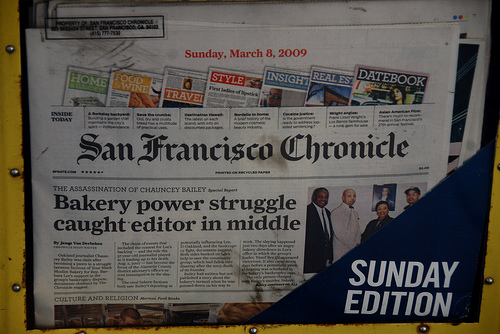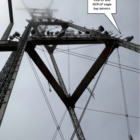 |
| Photo by Steve Rhodes |
We seldom think of oxygen unless it’s absent. You’d think about it a lot if it suddenly exited this room; you’d start gasping and writhing, your eardrums would burst, you and your neighbors would do a lot of bleeding on each other, then you’d die. But if we gradually replaced oxygen with nitrous oxide mixed with just a soupcon of cyanide gas, you might not notice that anything was missing at all; you might feel very content as your brain and body gradually turned off and you lapsed into a sleep without end.
I’ve frequently criticized the Chronicle for just that — for its lack of the kind of mental oxygen that makes for a healthy democratic polity. In my book “Imperial San Francisco: Urban Power, Earthly Ruin” I showed how it and two other leading San Francisco newspapers a century ago served the interests of their owning families — the deYoung, Hearst and Spreckels clans. All three detested each other to the point of murder, although they could all agree — as do all major newspaper-owning families and corporations to this day — that capitalism is the only acceptable means of arranging human affairs and that the value of land and the structures built upon it must continue to rise. They also agreed that an expanding U.S. empire in the Pacific Basin suited their own interests just fine.
As the young William Randolph Hearst advised his father in an 1885 letter, “Every atom of humanity added to the struggling mass means another figure to the landlord’s bank account.” All three media dynasties had very large real estate holdings and bank accounts that were replenished and enlarged by every atom added to the struggling mass far below those families. In addition, the power to shape mass thought by the ownership of print media provided the morally questionable deYoung brothers the opportunity to make themselves arbiters of San Francisco’s ancien regime, and a launching pad from which Mike deYoung hoped to attain the U.S. Senate and William Randolph Hearst the White House.
San Francisco a century ago had a vastly richer print media environment, like other American cities then and European capitals today. It had four major dailies and many other more specialized papers. Their competition and personal vendettas provided a lot of oxygen for readers of the time and fodder for me doing research for my dissertation that became the book since whatever scandals one family sought to hide from its readers the others would feature on their front pages. That is, up until Aug. 15, 1913, when Willie Hearst and Mike deYoung colluded to buy John Spreckels’ Call and add it to Hearst’s growing stable of yellow journals. As mining engineer and editor Thomas Rickard commented at the dedication of the Hearst Memorial Mining Building, the University of California spent four years educating young men and women, and the newspapers of Hearst and deYoung then diseducated them for the rest of their lives.
The Hearst-deYoung murder of San Francisco’s best paper sucked a lot of oxygen out of the room, but Rickard could not have imagined the diseducational potential of television, hate talk radio and the Internet later in the century. When the deYoungs in 1999 cashed out by selling the Chronicle to the Hearst Corp. after what one executive called some fancy horse trading with the Fang family to provide the illusion that San Francisco was not really about to become a one-newspaper town, New York’s privately held Hearst promised the Bay Area the world-class newspaper that it said we deserve. That would be a first for Hearst, I thought, having looked at decades of its inferior product on microfilm. Yes, the Hearst Chronicle is not the U.K.’s Guardian or France’s LeMonde. But then it’s not the Arizona Republic or the Honolulu Advertiser either. Over the years, it has provided space not only for its once-famous stable of columnists but for Armisted Maupin’s Tales of the City and for Randy Shilts’ superb reportage on the AIDS calamity and recently — however briefly — for Robert Scheer after the Los Angeles Times got rid of him for the crime of being too left of wing. It even occasionally publishes a letter or op-ed by me. But most of all, it has employed reporters who give us some idea of what is going on in our world. Like oxygen, we take them for granted, just as we once took California’s first-rate public education system for granted as we absentmindedly allowed it to incrementally become the worst. What if those reporters, like public education, were gone? What would replace it? And would we notice after a few days any more than we noticed we’d had a coup d’etat after a partisan Supreme Court put a pretender in the White House with the collusive support of the U.S. media?
I thought about that a lot as I read through some of the over 800 comments posted on SFGate after Hearst announced that it might sell or close the paper whose 144th anniversary it was celebrating even though a Sacramento Bee reporter once advised me for the sake of my mental health never to read those postings. A majority of posters danced on the Chronicle’s grave saying that they do not read or buy it because of its extreme left-wing bias and because it champions the homosexual agenda. Many rhetorically asked why they should pay for news when they can get it free on the Web. Ronald Reagan persuaded many that they should not pay taxes for vital public services such as public education, housing, transportation, health and safety; many today seem to believe that news simply materializes out of thin air, the sort of miraculous spontaneous generation that people in the Middle Ages believed in. We forget where the raw material for our thought comes from — and I include myself.
After reading those comments, I could well imagine a future in which news — however imperfect — is replaced by uninformed shouting, much of it the opinions of hate-filled radio gasbags dittoed forever by their nodding listeners. And I wonder what is to happen to reporters — especially to exemplary ones such as Robert Parry who try to do expensive investigative work with little support. I remember all too well what happened to Gary Webb when he was frozen out by his would-be colleagues.
I confess that I’m conflicted about the disappearance of the Chronicle, though not of the Hearst Corporation itself, as its lifestyle magazine profit centers die along with its newspapers. Both serve wealthy and powerful interests as they always have. I said in “Imperial San Francisco” that omission is a far more powerful tool of thought control than commission, and this becomes even more so when there is only one newspaper or none at all. Under editor Will Hearst, the old San Francisco Examiner actually did occasional investigations of the local power structure, but the Chronicle almost never does so except for its fine investigation of upper level corruption at the University of California. We all have our candidates for stories that should be looked at but are not; for me, the elephant in the living room whose presence the Chronicle will not mention is Senator Dianne Feinstein’s appalling voting record and conflict of interest with her financier and real estate magnate husband Richard Blum, chair of the UC Regents. I am told that both get enormous deference from the Chronicle’s editorial board as they do in Washington. Instead of investigation, Chronicle stories about Feinstein routinely describe her as California’s most respected centrist politician. The Chronicle has virtually assured her that if she wants to be governor of California next year, the job is hers.
However imperfectly, the Chronicle provides us with a great deal more oxygen than most of us are willing to acknowledge or know, and I fear for its absence. San Francisco without it will be like an Italian town without a piazza, and that is almost unimaginable.
Gray Brechin, Ph.D, is a historical geographer and author based in Berkeley. Links to more of his works and his contact information can be found at graybrechin.net.










